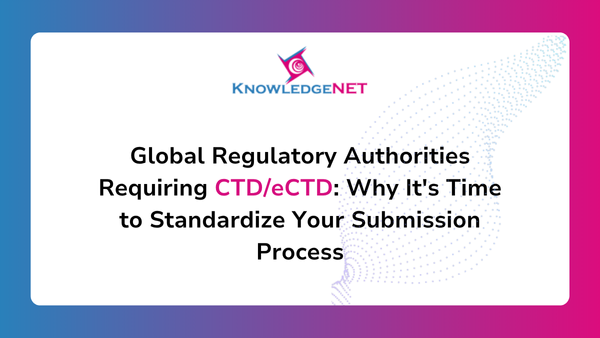Global Regulatory Authorities Requiring CTD/eCTD: Why It’s Time to Standardize Your Submission Process
In today’s global pharmaceutical landscape, regulatory submissions must meet highly structured standards—and those standards are rapidly evolving. As more countries transition from paper-based Common Technical Documents (CTD) to fully digital electronic CTD (eCTD) formats, companies are under increasing pressure to stay compliant across all regions.
Understanding which authorities require or accept CTD or eCTD is critical for regulatory teams managing global submissions. It’s not just about format—it’s about validation rules, lifecycle tracking, region-specific requirements, and technical readiness.
This blog presents a comprehensive list of global regulatory agencies currently using CTD/eCTD and explains why it’s time for regulatory operations to adopt scalable, region-agnostic submission solutions.
What Are CTD and eCTD?
- CTD (Common Technical Document): A standardized format for drug application dossiers agreed upon by ICH regions.
- eCTD (Electronic Common Technical Document): A digital version of CTD that enables electronic submission, validation, and lifecycle management.
While CTD brought consistency to content and structure, eCTD enables automation, traceability, and real-time global compliance.
Global Snapshot: Where CTD/eCTD Are Required or Accepted
✅ Regulatory Authorities Requiring or Accepting eCTD
These agencies have mandated or officially adopted eCTD as the standard format:
| Country/Region | Regulatory Authority | Format | Status |
| United States | USFDA | eCTD | Mandatory |
| Canada | Health Canada | eCTD | Mandatory |
| European Union | EMA | eCTD | Mandatory |
| United Kingdom | MHRA | eCTD | Mandatory |
| Switzerland | Swissmedic | eCTD | Mandatory |
| Japan | PMDA | eCTD | Mandatory |
| South Korea | MFDS | eCTD | Mandatory |
| Saudi Arabia | SFDA | eCTD | Mandatory |
| UAE | MOHAP | eCTD | Mandatory |
| Singapore | HSA | eCTD | Mandatory |
| Taiwan | TFDA | eCTD | Mandatory |
| Iran | IFDA | eCTD | Mandatory |
| Jordan | JFDA | eCTD | Mandatory |
| GCC-DR | Gulf Central Committee | eCTD | Mandatory |
| Egypt | Egyptian Drug Authority | eCTD | Mandatory |
| Australia | TGA | eCTD | Accepted / Optional |
| South Africa | SAHPRA | eCTD | Accepted / Optional |
| Malaysia | NPRA | eCTD | Accepted |
| Thailand | Thai FDA | eCTD | Accepted |
🔁 In Transition to eCTD
These countries are actively transitioning from CTD to eCTD and are expected to mandate eCTD in the near future:
| Country | Regulatory Authority | Current Status |
| China | NMPA | Transitioning |
| Brazil | ANVISA | Transitioning |
| Russia | Ministry of Health / Roszdravnadzor | Transitioning |
| Mexico | COFEPRIS | Pilot Phase |
| India | CDSCO | Planning/Transitioning |
| Ukraine | Ministry of Health | Transitioning |
✅ Regulatory Authorities Using CTD (Paper or PDF-based)
These agencies still use traditional CTD submissions but may accept electronic formats like NeeS (Non-eCTD electronic Submissions) or are planning to evolve:
| Country | Regulatory Authority | Format Used |
| India | CDSCO | CTD / NeeS |
| Indonesia | BPOM | CTD |
| Pakistan | DRAP | CTD |
| Bangladesh | DGDA | CTD |
| Vietnam | DAV | CTD / Hybrid |
| Philippines | FDA | CTD |
| Kenya | PPB | CTD |
| Nigeria | NAFDAC | CTD |
| Sri Lanka | NMRA | CTD |
Why This Shift Matters: From Fragmentation to Global Readiness
The growing shift from CTD to eCTD reflects a global regulatory trend toward digitalization, harmonization, and data traceability. However, the lack of consistency in implementation timelines and regional differences in Module 1 requirements creates complexity for companies operating in multiple jurisdictions.
To manage this, organizations need:
- A centralized system that supports both CTD and eCTD formats
- Pre-configured templates for country-specific Module 1 variations
- Built-in validation engines for each regulatory agency
- Tools for lifecycle management, version control, and audit trails
Conclusion: Prepare for a Global eCTD Future
The direction is clear: regulatory authorities around the world are converging on eCTD as the gold standard for dossier submissions. Whether you’re submitting to the FDA, EMA, or emerging markets like China and Brazil, your regulatory operations must be equipped to handle multi-format, multi-region, and multi-sequence submissions—seamlessly and compliantly.
If your team is still managing regulatory submissions manually or through fragmented tools, now is the time to consider a solution that supports global compliance without region-by-region customization.

